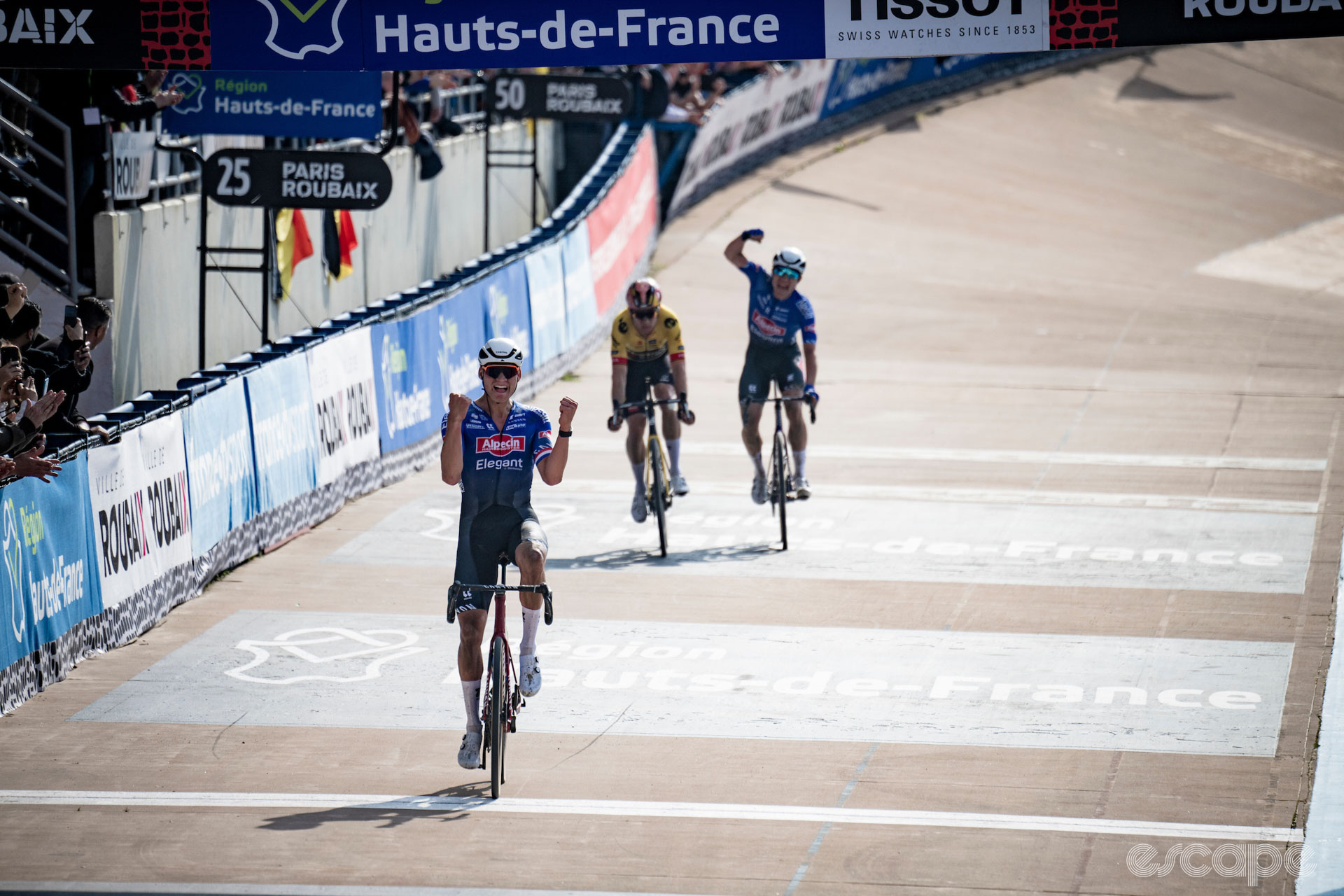Just like (almost) every other year for well over a century, Easter Sunday offered the peloton its last chance to find success over the cobbles on the biggest stage of them all.
The 'Queen of the Classics', the 'Hell of the North', Paris-Roubaix is always one of the most hotly anticipated race days of the year for riders and fans alike, capping off the Cobbled Classics. The third Monument of 2023 promised 256.6 kilometres of asphalt and cobbles through Northern France, with 29 iconic sectors in total including the infamous Trouée d'Arenberg (or Arenberg Trench), Mons-en-Pévèle and Carrefour de l'Arbre. Also certain to feature were crashes, bad luck and a huge amount of aggression from the main protagonists of this spring.
Of those star players, it was Mathieu van der Poel who ultimately celebrated in the Roubaix Velodrome, holding the advantage in both legs and luck.
Alpecin-Deceuninck shows ominous strength
With a tailwind filling the peloton's sails, it took over 80km for the four-man breakaway 'of the day' to squeeze off the front, and Sjoerd Bax (UAE Team Emirates), Jonas Koch (Bora-Hansgrohe), Derek Gee (Israel-Premier Tech) and Juri Hollmann (Movistar) were never allowed more than 90 seconds as they led the race onto the cobbles.
The race had been on from the start, and after a brief lull as the leaders built their slim advantage, it was all about positioning in the peloton.
Though Jumbo-Visma was determined to control proceedings and sustain their spring supremacy early on, along with a young and enthusiastic Ineos Grenadiers team, Alpecin-Deceuninck was best-represented as the race headed into the key early sectors, ensuring their leader(s) was out of trouble in the still stacked bunch. This was the first psychological knock to their rivals.
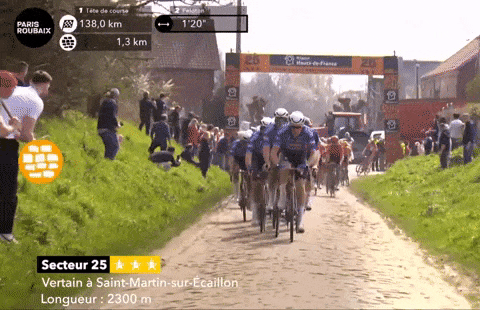
The front of the bunch, as always, proved the safest place to be. While the likes of Peter Sagan (who sadly did not finish his last-ever Paris-Roubaix after a heavy crash) were caught out further down, nearly all the favourites stayed out of trouble. For now.
Jumbo-Visma set up their leader
It's no secret that Jumbo-Visma has been the top team of the Cobbled Classics this season, especially early on when they seemed truly unstoppable.
However, Van Aert and his henchmen - as it happens, Christophe Laporte is actually their most successful rider of the spring - had a difficult day at Tour of Flanders last weekend, Van Aert managing fourth after a crash-marred traverse of the Belgian bergs.
The pressure was on for Paris-Roubaix, Van Aert's major goal for the season, and though there were moments when the team lost sight of one another in earlier phases, Jumbo-Visma was exactly where they needed to be as the race neared the crucial Arenberg Trench.

A small counter-attack had escaped from the peloton on the previous sector, but just 15 seconds up the road, the quintet represented little more than bait for the pack as it hit the four-star sector at speed.
No one wants to have to fight for position on the treacherous cobbles of 'the Trench', and with bad memories of the sector, Van Aert was taking no chances. Still on the Haveluy à Waller, the Belgian took over on the front and stretched the peloton to breaking point, just as he intended.
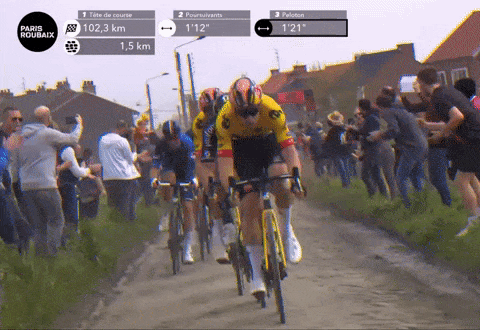
This effort saw Van Aert and Lieutenant Laporte go clear with 2015-winner John Degenkolb (DSM) Van der Poel and Stefan Küng (Groupama-FDJ), gathering Anthony Turgis (TotalEnergies) and 19-year-old Madis Mihkels (Intermarché-Circus-Wanty) from the counter-attack on their way - these two were the only survivors from that small group, albeit only briefly, the pair of them cruelly cast out on the upcoming Arenberg.
The race-defining selection had pretty much already been made before the race even met the edge of the Arenberg Forest. And by the end of the Trench, Van der Poel, Van Aert, Degenkolb and Küng had joined the remains of the early breakaway - Derek Gee and his front tyre were early victims of the Arenberg cobbles - while a small group including Mads Pedersen (Trek-Segafredo), Filippo Ganna (Ineos Grenadiers) and Alpecin-Deceuninck pair Gianni Vermeersch and Jasper Philipsen was chasing hard.
And crucially, while Van der Poel was about to gain two teammates, Van Aert had already lost his star domestique as Laporte suffered a fatal puncture in the Trench, and reigning champion Dylan van Baarle (Jumbo-Visma) had crashed out of the chasing pack in the same stretch. The Frenchman would eventually be joined by teammate Nathan van Hooydonck and Florian Vermeersch (Lotto Dstny), but their desperate chase came to nothing - though it did provide Van Aert with an excuse not to work too hard, if he wanted it.
The lifelong rivalry re-ignites
It was advantage Van der Poel as the elite front group charged onwards, Alpecin-Deceuninck using their numerical advantage to repeatedly punish the rest of the group. They pushed the pace at every opportunity, their probing accelerations testing the others, and eventually reducing their number to just seven.
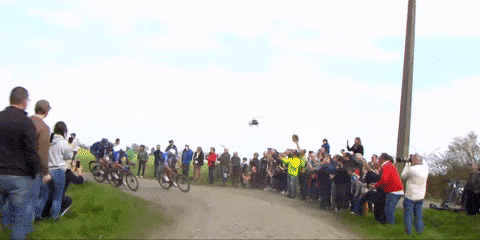
Paris-Roubaix is famously a race of attrition. It is knackering. And once a gap is created, it can be very hard to close.
While Van der Poel and Alpecin-Deceuninck were hell-bent on aggression, the fastest to respond were invariably the resurgent Degenkolb and Van der Poel's lifelong rival, Van Aert. Of course.
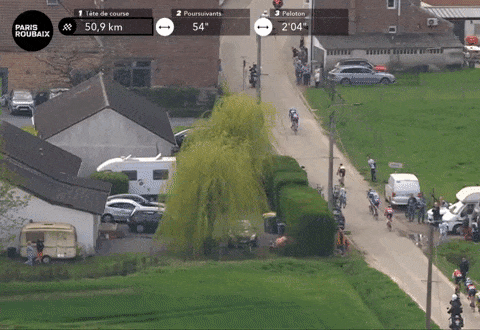
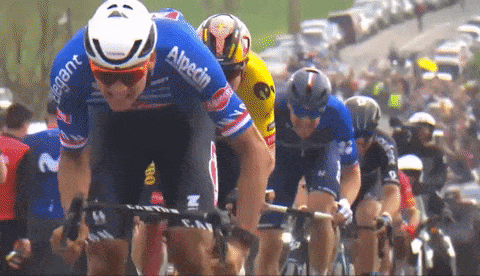
Chaos on Carrefour
If you were to ask where the race was won, a major contender would be the Carrefour de l'Arbre, the last five-star sector of the race that started just outside 17km to go.
At the start of the 2,100-metre sector, the same seven riders who'd clung to one another so indefatigably for so long were still together.
Something was bound to happen on this iconic stretch of cobbles - it had to soon - but while the outcome was not wholly unexpected, the manner of its conception was something else.
Philipsen led the group as Degenkolb left the line in favour of the smoother stretch by the verge. Here he was able to accelerate forward, seeing a gap alongside Philipsen. However, Van der Poel saw exactly the same opening and a chance to attack, a route that would put teammate Philipsen between himself and Van Aert which might hold up his rival, if only briefly.
Unfortunately, it was in the very moment that Van der Poel and Degenkolb aimed for the same hole that Philipsen moved to his right and plugged it.

With the only former Paris-Roubaix champion in the group picking his stunned self - the devastation and anguish would come later - off the dusty cobbles, six riders were left in the race. But not for long, as Van Aert took advantage of the chaos and attacked.
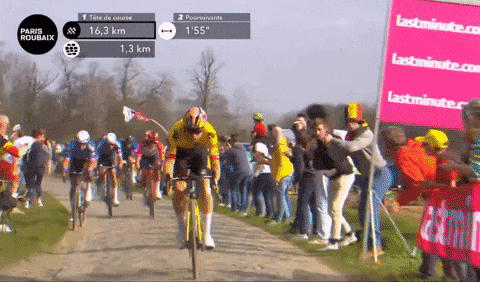
This was it. This was the moment that Van Aert dug in to make the race-defining attack he'd planned. And it seemed to be working.
Sure, Van der Poel was able to latch on, but that's ok. That was pretty much inevitable. And Van Aert had already beaten his arch-enemy in a flat-out sprint at E3. He could deal with that...
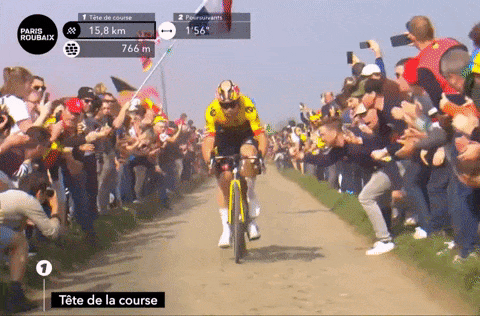
Last week it was 'The Big Three'. This week, the 'Big Two'. Just as everyone had anticipated. But Van Aert reached down and yelled something into his radio just as Van der Poel came through, and he wasn't saying, "It's happening!"
At the worst possible moment, Van Aert had punctured.
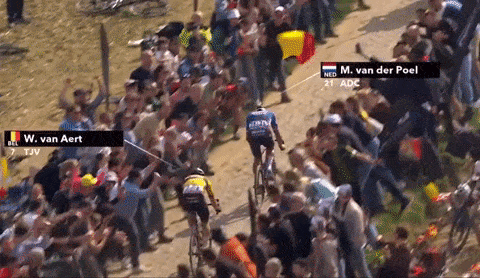
Van der Poel left the Carrefour de l'Arbre alone and alone he stayed, as Van Aert was forced to take a rear wheel from an end-of-sector helper and join the futile chase.
No guts, no glory
From the end of the Carrefour de l'Arbre, there are only 15 kilometres and three cobbled sectors (including the more-or-less ceremonial one-star Roubaix stretch) before the velodrome finale.
The situation for Van der Poel was very similar to last week, only this time he was the lone leader, while the chase behind could not get organised, largely thanks to Van der Poel's teammate Philipsen's dogged determination.
At one point the leader's margin dipped to a tantalising 20 seconds or so, but Philipsen's presence in the chase group and a lack of willingness or strength to help Van Aert proved fatal, and though the Belgian was able to jettison enough rivals to ensure a podium finish, in the end the margin of victory was 46 seconds.
It wasn't plain sailing for Van der Poel, though, as he took some very risky lines, especially between the bollards on the Willems à Hem sector. Perhaps he didn't trust the time gaps. Perhaps he was just having too much fun. Regardless, his bike handling in one sketchy right-hander defied reason as well as physics - it seemed impossible that he'd get both wheels around the bollard and back on the cobbles given how far over he was.
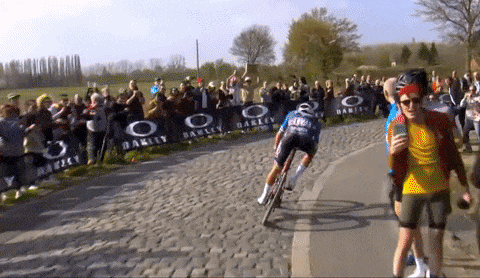
But he made it. Van der Poel entered the final kilometre and rode into the sun-kissed Roubaix Velodrome with time to savour it. The victory was his.
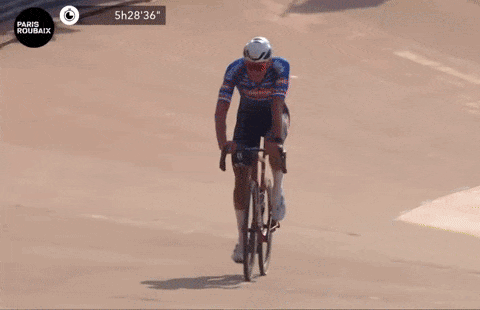
The finish was special, not to mention unique to this race. As Van der Poel punched the air in triumph, his teammate did exactly the same not far behind him, only in reality, Philipsen and Van Aert had a lap to go.
Perhaps inevitably, Philipsen was then able to get the better of a dejected Van Aert to make it an Alpecin-Deceuninck one-two.
Did we do a good job with this story?

